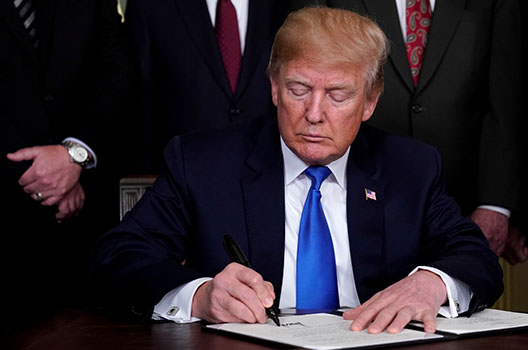 The trade war being waged by US President Donald J. Trump’s administration is one of the major risks to global growth outcomes for this year and next. Markets have been busy digesting a steady flow of trade-related news, such as possible investment restrictions on Chinese firms wanting to do business in the United States and the announcement by Harley-Davidson that it plans to shift some production overseas to avoid European Union (EU) tariffs that come in response to US steel and aluminum tariffs. Tariffs and counter-tariff measures over time result only in losses and trade wars cannot be “won” in any meaningful economic sense.
The trade war being waged by US President Donald J. Trump’s administration is one of the major risks to global growth outcomes for this year and next. Markets have been busy digesting a steady flow of trade-related news, such as possible investment restrictions on Chinese firms wanting to do business in the United States and the announcement by Harley-Davidson that it plans to shift some production overseas to avoid European Union (EU) tariffs that come in response to US steel and aluminum tariffs. Tariffs and counter-tariff measures over time result only in losses and trade wars cannot be “won” in any meaningful economic sense.
The current disarray in trade relations is likely to last through the summer and fall as the Trump administration has ample domestic political and economic room for maneuver. The following three factors support its position:
The administration inherited a robust economy at risk of overheating and any job losses due to counter-tariffs take pressure off the labor market. When Trump took office in 2017, the economy was already at or near full employment and has continued to add jobs at a pace of almost 200,000 a month since then. The US economy is at some risk of overheating and inflation. As such, job losses here and there due to the tariff tantrum, combined with the gradual interest rate increases by the Federal Reserve, provide some relief. It is possible that the administration is deliberately using tariffs, which act as the rough equivalent of a domestic tax increase, as a way to reduce consumption and aggregate demand.
The tariffs and countermeasures by other countries have limited domestic political impact for the administration. The retaliatory tariffs imposed by the EU, China, and Canada are designed to have a significant impact in those states that supported Trump in the 2016 elections. But their implementation is gradual, many prices take time to adjust, and job losses due to the counter-tariffs will not be sufficient to meaningfully affect the prospects for Republican candidates in the midterm elections in November. The president uses the countermeasures as further justification of his policies and currently enjoys record-high approval ratings within his base.
The US dollar continues to be strong. The impact of the administration’s own tariffs is muted by the strong US dollar, which is supportive of the global purchasing power of American consumers and manufacturers even as tariffs are imposed by the United States on a growing list of goods.
The Trump administration’s negotiating strategy on trade topics appears two-pronged: the administration puts on public display the significant disruption to trade and business it is willing to engage in (through the threat of tariffs, mixed messages, etc.), and simultaneously makes only a handful of cabinet members and senior advisers available for meaningful negotiations. Counterparties are forced to respond given the often-significant economic stakes, but face considerable challenges when it comes to progressing their own agenda in the negotiations or even getting time on the calendar.
The administration has displayed a clear preference for bilateral negotiations, and has, over the past two months, prioritized its dialogue with the Chinese government over traditional trade partners and allies. Given the longstanding concerns about China’s trade practices, and the significant and credible threat of further tariff escalation, the United States may well be able to accomplish concessions from the Chinese government that it can present as a “win” politically. Longer term, the disarray in the (trade) relations of the United States with its historical allies in Europe and elsewhere is a meaningful geostrategic concession to Beijing, which the Chinese government is eagerly exploiting as it pursues its own global leadership and agenda.
Prospects for completion of a renewed North American Free Trade Agreement (NAFTA) are slim to none this year, though US officials have recently voiced optimism that an agreement could be imminent. The Mexican presidential and parliamentary elections are days away, and an agreement could possibly be negotiated with the incoming Mexican president over the summer, though approval of any agreement by the US Congress ahead of the midterm elections appears highly unlikely. Another obstacle is that following President Trump’s antics at the recent Group of Seven (G7) meeting in Québec, public sentiment in Canada is not favorable towards constructive engagement with, or concessions to, the United States on trade topics.
Last on the administration’s priority list when it comes to constructive talks about trade topics appears to be the EU, with a variety of recent decisions and statements by the president and others souring the prospects for imminent progress: the use of national security as an argument for the imposition of steel and aluminum tariffs, the withdrawal from the Iran nuclear agreement, the threat of car tariffs, and tensions surrounding the upcoming NATO summit, to name just a few recent irritants.
All signs, therefore, point to a continued escalation of tariff battles and limited progress on key negotiations. With the United States, the EU, and China combining for approximately 60 percent of the global economy, the ongoing tensions will continue to create significant market volatility, dampen investment, and form the most meaningful threat to global growth prospects.
Bart Oosterveld is director of the Atlantic Council’s Global Business and Economics program.
Image: U.S. President Donald Trump signs a memorandum on intellectual property tariffs on high-tech goods from China, at the White House in Washington, DC, U.S., March 22, 2018 (Reuters/Jonathan Ernst)

